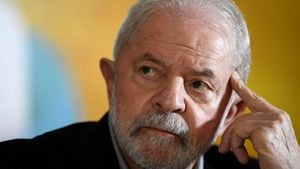On December 12, 2024, the European Central Bank (ECB) is poised to hold its final interest rate meeting of the year, and the financial world is buzzing with anticipation. With the eurozone's economy showing mixed signals, expectations are set for yet another rate cut, likely by 25 basis points, bringing the deposit facility rate down to 3%. This reduction follows several cuts throughout 2024, as policymakers grapple with sluggish growth and persistent inflationary pressures.
The ECB has maintained its deposit rate at 4% since September, prior to embarking on its current easing strategy. This shift has been largely driven by economic indicators highlighting consistent weakness across major industrial nations within the eurozone, especially Germany, which has historically been the economic powerhouse of the region. Analysts are carefully watching the meeting, as any hints of future policy adjustments could have significant ramifications for the euro and the broader market.
While market forecasts are widely leaning toward the expected 25-basis-point cut, there remains an air of uncertainty. Some analysts believe the ECB's messaging might suggest the possibility of larger moves if economic conditions worsen – potentially hinting at future cuts beyond this December meeting. Recent inflation figures have settled near the ECB's 2% target, which complicates matters; even though the headline inflation numbers are encouraging, underlying core inflation has resolutely held above target levels.
For example, core inflation has consistently hovered around 2.7%, which elevates concerns over wage growth and pricing pressures. Recent data indicated negotiated wage increases climbed to 5.42% during the previous quarter, which could pressure businesses to raise prices. Such factors have made many analysts skeptical about how much lower the ECB can or should reduce rates without jeopardizing inflation stability moving forward.
Goldman Sachs has suggested this latest cut is part of a broader strategy to stimulate subdued economic growth expected across the region until 2025. According to Jari Stehn, Chief European Economist at Goldman Sachs, lower rates could facilitate increased savings and consumer spending, effectively boosting economic activity and fostering growth for next year. Johan van Reenen, another finance analyst, emphasized the importance of this rate cut for economic sentiment across the eurozone, noting it could bolster consumer and business confidence alike.
Interestingly, this meeting arrives amid heightened tensions from potential trade issues with the United States. Stefan Gerlach, Chief Economist at EFG Bank, pointed out the “big question” surrounding how incoming U.S. policy changes could impact eurozone growth. If President-elect Trump's administration implements heavy tariffs, the eurozone economy, already fragile due to sluggish growth, could face even harsher realities. Gerlach speculated, “If we see trade barriers, I can well picture the ECB responding with more rapid rate cuts.”
The strategic decisions being made at this meeting are meaningful not just within the eurozone, but globally as economies remain intertwined. The reactions from various markets will likely hinge heavily on the ECB's forward guidance and any hints at future monetary policy paths. Specific indicators to watch will be macroeconomic projections released post-meeting concerning inflation and economic forecasts – all of which will influence market traders as they assess their positions.
Meanwhile, the U.S. dollar is experiencing slight upward momentum, driven by recent inflation data showing consumer prices rising at their fastest pace for four months. Such conditions prompt speculation around the Federal Reserve's upcoming policy decisions and ignite discussions on how global rates interrelate.
The ECB must strike a fine balance; as it contemplates its next moves, it must not only focus on the immediate economic indicators but also prepare for the potential global economic ripple effects. The decision to cut rates signifies cooperation between policymakers and market participants, aiming to restore confidence within the eurozone as growth appears stunted.
Overall, December 12 promises to be more than just another rate-setting day for the ECB. It’s set to reflect the struggles and responses of the eurozone's central bank to navigate through turbulent economic waters, providing hopeful signals to the public, investors, and economists yearning for stability and growth prospects.



